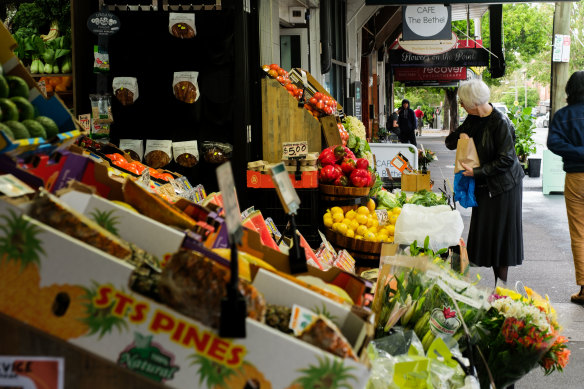By Shane Wright and Millie Muroi
Inflation has fallen to its lowest level in three years as government power rebates, tumbling petrol prices and cheap bread deliver much-needed relief to households.
And there are signs it is falling even faster than expected by the Reserve Bank.
In figures described by Treasurer Jim Chalmers as “heartening and encouraging”, the Australian Bureau of Statistics monthly measure of inflation fell to 2.7 per cent in August after it had eased to 3.5 per cent in July.
Underlying inflation, which Reserve Bank governor Michele Bullock said this week was her institution’s main focus, eased 0.4 percentage points to 3.4 per cent.
It is now lower than the RBA had expected underlying inflation to be by the end of September and is back where it was in February 2022, just before the spike in global commodity prices caused by the war in Ukraine.
The steep fall in August was partly due to a huge drop in electricity prices, which have been pushed down by federal and state government rebates. The annual inflation rate for electricity, which was 7.5 per cent in June, fell to a record low of minus 17.9 per cent in August.
The decline in electricity prices accounted for about a third of the total drop in inflation. Without the government rebates, inflation still would have eased below 3 per cent because of other price falls.
Annual inflation for petrol to the end of August fell to minus 7.6 per cent. Since then, petrol prices have continued to drop.
According to the bureau, petrol averaged $2 a litre in August last year. Last month, the average was $1.85.
The falls in electricity and petrol prices were not included in the underlying inflation measure, pointing to disinflation across the rest of the economy.
Annual rent inflation eased to 6.8 per cent, after hitting 7.7 per cent in March, bread inflation slipped to 2.5 per cent from 4.4 per cent, clothing fell further to 1.7 per cent from 1.9 per cent while communications inflation is now negative at minus 0.2 per cent.
There were some price increases. The annual inflation rate for fruit and vegetables soared to its highest level since late 2022 at 9.6 per cent as poor growing conditions pushed up prices for strawberries, grapes, broccoli and cucumbers.
While inflation for goods fell to just 1.4 per cent, its lowest level since March 2021, services inflation – a particular concern for the RBA – only eased to 4.2 per cent.
There had been fears among some economists that inflation would re-accelerate with the start of the stage 3 tax cuts and the 3.75 per cent lift in the minimum wage. But during the first two months of the financial year, inflation has actually fallen by 0.2 per cent.

Fruit and vegetables were one area where prices rose sharpest, up 9.6 per cent over the year to August.Credit: Oscar Colman
Inflation could fall even further in October, with the bureau noting some government electricity rebates had yet to be paid. The national average petrol price last week fell to $1.74 a litre.
Chalmers said while government actions had contributed to some of the easing in inflation there were other signs that overall price pressures continued to ease.
“We expected headline inflation to come down. We have also seen underlying inflation come down considerably as well and that is a very good thing. Our policies are a factor here but they are not the only factor,” he said.
But shadow treasurer Angus Taylor said the overall economy was barely growing while household incomes were falling in real terms.
“The result of all of that is we have seen Australians’ standard of living smashed, a disastrous outcome for Australian households and indeed around a 9 per cent reduction in real disposable incomes in the last two years,” he said.
The Organisation for Economic Co-operation and Development is also expecting inflation to fall quicker than expected in Australia over the coming 12 months.
In its latest economic outlook, released on Wednesday evening, the Paris-based think tank said it now believes Australia’s inflation rate will ease to 2.4 per cent in 2025. In May, the OECD forecast 2.9 per cent.
The lower inflation rate, however, will be partly due to a more sluggish economy, with the OECD downgrading its expectations for Australian economic growth to just 1.8 per cent next year.
Ratings agency S&P Global, which on Wednesday reaffirmed Australia’s triple A credit rating, said it also expected inflation to ease in the coming year. Australia is one of 11 nations with a triple A rating.
Betashares chief economist David Bassanese said the notable fall in underlying inflation had marginally increased the chance of a pre-Christmas interest rate cut while the drop in headline inflation beyond the impact of electricity rebates was encouraging.
“If annual trimmed mean inflation does not once again lurch higher – but continues its recent trajectory lower – there is a growing chance it could reach the mid-point of the RBA’s 2-3 per cent target band by year-end, which would be significantly better than current RBA forecasts,” Bassanese said.
“If so, there would be a good chance the RBA could cut interest rates before Christmas.”
Cut through the noise of federal politics with news, views and expert analysis. Subscribers can sign up to our weekly Inside Politics newsletter.